Blues Reviews
June/July 2018
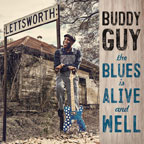 Buddy
Guy
Buddy
Guy
The Blues Is Alive and Well
Silvertone/RCA 2018
The subtitle of Buddy Guy’s newest release could be “defying
mortality with vitality.”
Deserved winner of innumerable Grammys and Blues Music Awards, legendary
guitarist and singer Guy has never had a creative lull in his long career,
from his 1950s stint as valued session man to his decades as part of the
acclaimed blues duo with Junior Wells to his subsequent storied solo career.
However, his creative alliance since 2008 with producer Tom Hambridge
arguably has led to some of his finest achievements. Both 2013’s
“Rhythm & Blues” and 2015’s “Born to Play
Guitar” won multiple accolades. It will be no surprise if this new
release is deemed equally worthy.
Comprising fifteen songs clocking in at a full hour, “The Blues
Is Alive and Well” displays Guy at the undiminished peak of his
powers. His singing, often overlooked by those dazzled by his guitar wizardry,
is powerful and evocative, and he can deftly squeal, shriek, and ascend
to falsetto. Unlike many blues singers, he also enunciates clearly, allowing
appreciation of song lyrics.
Those lyrics are alternately pithy, poignant, and jocular. All but two
of the tunes are credited to Hambridge, solely or in cooperation with
a co-writer, Guy on several. Kudos go to the sterling group backing Guy,
returning from his last couple of albums: Hambridge on drums, Willie Weeks
on bass, Kevin McKendree on keyboards, and Rob McNelley on rhythm and
slide guitars, with the Muscle Shoals Horns thrown in for good measure.
That group could revive the dead.
Speaking of which: at eighty-one years old, Guy is obviously and understandably
contemplating the inevitable demise facing us all. He addressed the issue
in 2010’s “Living Proof,” with the songs “74 Years
Young” and “Stay Around a Little Longer” (referring
to B.B. King), and in “Rhythm & Blues” with “I Could
Die Happy” and “All That Makes Me Happy Is the Blues.”
“Born to Play the Blues” alluded to mortality with the title
cut and “Come Back Muddy.” Here his pensive exploration of
mortality begins with the opening track, “A Few Good Years.”
It’s characterized by his gorgeous and plaintive single note guitar
leads buttressed by McKendree’s haunting organ fills.
The next cut, “Guilty As Charged,” is a driving mid-tempo
shuffle. It’s followed by “Cognac,” featuring guest
guitarslingers Jeff Beck and Keith Richards, both among the myriad of
six-string mavens who cite Guy as a major influence. Richards sticks to
a blues trope, Beck adds some psychedelia, and the three mesh scintillatingly.
There is no letdown with the ensuing title cut, a languid number distinguished
by the appearance of the Horns. Its successor, “Bad Day,”
is equally compelling: a stinging Chicago shuffle with pithy harmonica
by Emil Justian.
We’re barely getting started! “Blue No More” ratchets
down the pace, with Guy trading vocals with young British sensation James
Bay, then “Whiskey for Sale” fully enters funk territory,
replete with a trio of backing singers and ample wah-wah pedal. (Did I
mention that the late guitar icon Jimi Hendrix was profoundly influenced
by Guy?) No less than Mick Jagger emerges on “You Did the Crime,”
and distinguishes himself without singing a note as he demonstrates his
harmonica proficiency. “Old Fashioned,” written by Guy with
Hambridge, reveals that Buddy prefers the proven to the avant-garde, and
is succeeded by the similarly revelatory “When My Day Comes”:
“I heard that train a-comin’/Across the county line/The good
Lord heard my prayer/Cause that train right on time.”
After a gritty and nasty cover of Sonny Boy Williamson II’s (Rice
Miller) classic “Nine Below Zero,” the group blasts into “Ooh
Daddy,” and it’s time to dance! as Guy and McNelley interplay
deftly. Then we return to the theme of mortality: “Somebody Up There”
deploys Buddy’s strong vocal and screaming guitar in a tale of gratitude
for his fulfilling life, and “End of the Line”…well,
it’s poignant, with Guy proclaiming “When the clock on the
wall says late/I’ve still got one more to play” but “I’m
the last one to turn out the lights.” It’s impossible to listen
without recalling the deaths of B.B. King, Bobby “Blue” Bland,
Robert Lockwood Jr., Koko Taylor, and many other seminal blues greats
in the last decade.
Fortunately, Buddy Guy is still with us, and still carrying the blues
torch with skill and soul. He will not go gently into the night, and he
emphasizes his enduring vivacity with a one minute ribald closer, “Milking
Mutha for Ya,” just Buddy and his electric Gibson having a good
time at the close of another superb album.—Steve Daniels
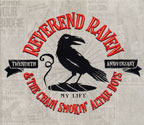 Reverend
Raven & The Chain Smokin’ Altar Boys
Reverend
Raven & The Chain Smokin’ Altar Boys
My Live, Twentieth Anniversary
Nevermore Records reverendraven.com
If anyone lives long enough the term legendary can be used as part of
their official title and so it shall be with the Reverend Raven &
The Chain Smokin’ Altar Boys newest release “My Life, Twentieth
Anniversary.” It’s a compilation of sixteen all-original tunes
taken over the nicotine-stained breadth of his career. The Reverend joined
the Blues Disciples in 1998, converted those disciples to Altar Boys but
like any good clergy knows Altar Boys don’t last forever and he’s
offered up a host of smoking players over the years. “My Life”
includes four drummers: Vic Span, Spencer Panosh, Bobby Lee Sellers Jr.,
Craig Panosh, three bass players: Jeff Roberts, Andre Maritato, PT Pedeersen,
four keyboard players: Ron Kovach, Danny Moore, Mickey Larson, Jimmy Voegeli
and four harp players: Cadillac Pete Rahn, Madison Slim, Benny Rickun
and Westside Andy. The Reverend on guitar and vocals is the only constant
element of this compilation and the real testament to this band leader
is that every song has a consistent sound, they all could have been recorded
in the same session. The Rev leads his congregation with his smooth, smoky
vocals and swinging guitar against a crooning harp and keys.
Starting off with a few tunes from his first record, 1998’s “Slow
Burn” featuring Cadillac Pete Rahn, each song is a small short story
with all the things the “Handyman” can fix, the Slim Harpo-like
“Bee Hive Baby,” the upbeat “Creature Of Habit”
and adding Madison Slim for his “Bad Little Girls.” Then jumping
to his 2005 “Live At Blues On the Grand” Raven slides into
“I Want To Love You” but “Once The Women Start Talking”
about the “King Bee”-like “Big Bee” then it’s
“Here Comes My Baby.” The remainder of this set is mixed from
2010’s “Shake Your Boogie” and the 2015 release “Live
At the Big Bull” along with a few unreleased tracks splitting the
harp between Benny Rickum and Westside Andy Linderman. With the title
tune “My Life” Raven recounts his Naval time where he was
first ordained and his days of “Looking for Love,” the tour
de force “Praying for A Princess” with Benny Rickum’s
harp and Danny Moore on piano. Taking a “Slow Burn” the Rev
pleads baby “I Can Do You Right” but it’s “Someday
When I’m Dead And Gone” and “She’s Moving On.”
Saving the best till last “I’m Your Honeyboy” has Westside
Andy and Moore swinging so hard they had to fade it out as Raven claims
“satisfaction is guaranteed” and with everything on the legendary
Reverend Raven & The Chain Smokin’ Altar Boys “My Life,
Twentieth Anniversary” that is a fact.—Roger & Margaret
White
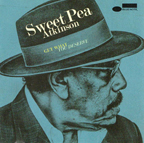 Sweet
Pea Atkinson
Sweet
Pea Atkinson
Get What You Deserve
sweetpeaatkinson.net bluenote.com
Back in the late ’70s Don Was first saw Sweet Pea singing at a UAW
hall with some fellow auto workers and immediately recognized this was
the real deal. Recruiting him as one of the lead singers on his first
LP “Was (Not Was),” he also co-produced Atkinson’s first
solo album “Don’t Walk Away” in ’82. Moving to
LA, Atkinson was involved with Brian Wilson, Bonnie Raitt, Bob Dylan,
Willie Nelson, Solomon Burke, George Jones and spent over a decade on
the road with Lyle Lovett’s band. With close to forty years in the
recording business, Sweet Pea’s newest disc ,“Get What You
Deserve,” is Atkinson’s second solo release. Production was
split between Was and Keb’ Mo aka Kevin Moore, who first met Atkinson
in the late ’90s. He says “Sweet Pea is one of the last great
R&B/soul singers. He’s a man of charisma and style, a timeless
talent who’s greatly respected by his peers, and the epitome of
cool. They don’t make ’em like that anymore.” Backed
by a Motor City-centric band featuring former bandmate Randy Jacobs (The
Boneshakers) on guitar, James Gadson drums with the basses of Reggie McBride,
Don Was and Marcus Miller with a host of other players too long to list.
All that said, hearing is believing so give it a spin and you’ll
“Get What You Deserve.”
The first set produced by Was features two bits of classic soul from Freddie
Scott, “Are You Lonely For Me Baby” also recorded by Al Green
and Otis Redding, then digging deep on “Am I Grooving You”
Sweet Pea owns these songs as if they were his own. Going straight for
the funk Atkinson takes on James Brown’s “You Can Have Watergate”
his voice strong and clear ringing with authority as Mindi Abair’s
sax blasts on through. The remaining tracks are produced by Keb Mo’
and Sweet Pea takes on two of his songs. In his element on “Slow
Down” laying back letting his voice ooze out around the rhythm as
Jacobs burns between verses, then stepping up the funk, whooping and hollerin’
to the girls on “Just Lookin’.” From here it’s
nothing but solid gold soul with Sweet Pea putting his stamp on each tune.
Taking on Bobby Bland’s “Ain’t No Love In The Heart
Of the City” is given a deep soul reading and Johnny Taylor’s
“Last Two Dollars” sounds heartrendingly real. Settling into
an easier groove with Bobby Womack’s “You’re Welcome,
Stop On By” his phrasing sounding as if he’s walking down
a street before taking a sidestep to a restrained ballad on the Temptations
“Just Another Lonely Night.” The title tune, “Get What
You Deserve,” written and backed by “Wyzard” Jerry Seay,
is a major hip hop detour.
“Get What You Deserve” is an all-covers disc but he puts so
much of himself in, all you hear is Sweet Pea Atkinson.—Roger &
Margaret White
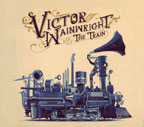 Victor
Wainwright and The Train
Victor
Wainwright and The Train
victorwainwright.com
Ruf Records rufrecords.de
Victor Wainwright was destined to play boogie woogie piano. He came from
a long line of players and experienced Jerry Lee Lewis while sitting on
his grandfather’s shoulders as a young lad. Mentored by the Rev.
Billy C. Wirtz in barroom excess and boogie woogie, Victor has beaten
that box for more than a decade and is now ready to release “Victor
Wainwright and The Train.” He’s co-produced this with Dave
Gross, written all the songs and has dedicated it to grandfather Jesse
Wainwright. His vocals have a throaty Southern drawl and he’s added
B3 organ and lapsteel to his bank of sounds while his band features Pat
Harrington guitar, Billy Dean drums and Terrence Grayson bass which he
augments with Mark Earley on sax and flute, Doug Woolverton trumpet, Reba
Russell vocals and various guitarists.
The boogie piano jumps on board the “Train,” “buy yourself
a ticket or get out of the way” through a fanfare of horns and the
crowds shouting “woo woo” like a train whistle and you know
you’re in for a rollicking ride. Blasting off with thunderous piano
runs joined by horns on a gospel “Healing” quieting to gentle
piano and whisper till the organ and guitar press forward in a full force
rave up. A man of Victor’s considerable girth is warned by his Dr.
and his Mama wants him in church but he replies with the boogie “I’ll
Start Tomorrow” ’cause he’s having too much fun today
and if you got the “Boogie Depression” a healthy dose of Jerry
Lee Lewis is the cure. Deep twanging guitar against Victor’s deadly
growl tells the unfortunate tale of Peggie’s “Wiltshire Grave”
with creaking B3 and blaring trumpet. Victor’s aching voice croons
a Beatle-like “Dull Your Shine” as he pulls up a lapsteel
before returning to a delicate piano. The energy builds as the Train picks
up the pace headin’ towards “Righteous,” a North Mississippi
blues with Josh Roberts ridin’ the rails on lead guitar. Pat Harrington’s
slide guitar is worthy of Derek Trucks as Victor’s vocals and B3
slowly heat up with “Sunshine,” a hot extended jam. Victor’s
storytelling lyrics pay off, starting with a loan that demands “don’t
forget about my” “Money” followed by the IRS, gangsters
and church all asking that same question and his heartfelt appreciation
for B.B. King in “Thank You Lucille,” with Monster Mike Welch
on guitar. Victor’s vocals dominate “Everything I Need”
over a gentle reverb-drenched guitar with B3 and piano and the final track
feels like a soulful prayer as Victor sings “That’s Love To
Me” and shows he’s a whole lot more than a boogie woogie piano
player.
With his newest CD, “Victor Wainwright and The Train,” this
big man of boogie has grown in leaps and bounds to create music that everyone
can jump on board with.—Roger & Margaret White
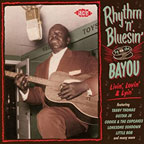 Rhythm
‘N’ Bluesin’ By The Bayou: Livin’, Lovin’
& Lyin’
Rhythm
‘N’ Bluesin’ By The Bayou: Livin’, Lovin’
& Lyin’
Various Artists
Ace CD 1514
From New Orleans in the east to Lake Charles in the west, local rhythm
‘n’ blues 45’s not only entertained the black residents
of South Louisiana and kept the taverns and juke joints packed in all
the tiny towns along Route 90 and nearby parishes, but inspired an entire
generation of white performers, not only influencing their music but engendering
the incipient sound that came to be known as swamp pop. Among the 28 tracks
presented here in the, count ‘em, 19th volume of Ace’s “By
The Bayou” series and the sixth devoted to R&B, can be heard
not only the dance floor filling sound of Cookie and the Cupcakes (of
“Mathilda “ fame), the tough, no-nonsense blues of Baton Rouge’s
Tabby Thomas (owner of the fabled club, Tabby’s Music Box)
and three early tracks by ex-Clifton Chenier axeman Guitar Jr. (before
he moved to Chicago and became Lonnie Brooks) but eleven groovin’
and hitherto unissued selections by little knowns like Little Nolton (with
his quizzical “Don‘t Know Why), Elizabeth (that’s all
it said on the tape-box) with a cover of Barbara George’s hit “I
Know” and Clarence “Frogman” Henry-inspired Eddie Williams
with his novelty take-off “Baby’s Got Bad Feet” as well
as a pair of numbers by a totally-unknown artist—who channels Lloyd
Price on the easy rocking invitation “Love Me Chile” while
nicely slowing affairs down on a heartfelt “Won’t Be Blue
No More.” Tracks by Lonesome Sundown, Charles “Mad Dog”
Sheffield, King Karl, Tal Miller and Joe “Google Eyes” August
also impress. For best results, follow ace liners author Ian Saddler’s
succinct advisory and “crank up the sound system.”—Gary
von Tersch
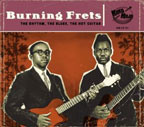
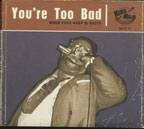 Burning
Frets
Burning
Frets
Various Artists
Koko Mojo CD 07
You’re Too Bad
Various Artists
Koko Mojo 09
www.koko-mojo.com
These two decks are from a, count ‘em, recent “eight set series”
of particularly choice and, incidentally, very collectable blues, rhythm
‘n’ blues and black rock ‘n’ roll rarities, with
a little vintage rockabilly on the side. The Koko Mojo label is an offshoot
of Rockstar Records, part of ex-Bear Family boss Richard Weize’s
new venture, with this debut, artfully themed and vintage imaged, 180
track series, ably compiled by DJ Lil Victor (aka “Mojo Man”)
and, throughout (except for the lack of liner notes), more than up to
the usual top-quality Bear Family standards. Burning Frets accents guitarists—ear
catchers include Guitar Shorty with his tale of “The Ways Of A Man,”
The Sharps with the novelty “Have Love Will Travel” (with
Duane Eddy on guitar), John Fred and his Playboys with a boogified “Boogie
Children,” a dynamic recall of John Lee Hooker’s “Dimples”
from The Fabulous Silver Tones and Blue Charlie’s “chickin’
pickin’“ on a freewheeling “Gonna Kill That Hen”
to mention only a few. One title, in particular, catches the eye as well
as the ear—performed by the mysterious Boliver Shagnasty (that some
suspect was rockabilly legend Rusty York) the outrageously bawdy “Tappin’
That Thing” would have made Lucille Bogan blush. You’re Too
Bad is an outstanding blues harmonica compilation with some great sides
such as Juke Boy Bonner’s complaining testimonial “Well Baby,”
Harmonica Fats lamenting that “My Baby Didn’t Come Home,”
Little Walter’s observational “Crazy Mixed Up World,”
Little Boyd & The Blues Bees’ pleading “Don’t Leave
Me Baby,” Big Ed Burns with the wild tale of his “Biscuit
Baking Mama” and John Brim’s dangerously colorful “I
Would Hate To See You Go,” featuring Little Walter.” As the
Mojo Man puts it: WOWzer! BLOW MAN BLOW! I’ll review another couple
discs in this aurally rewarding series in the next issue. Stay tuned!—Gary
von Tersch
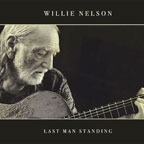 Willie
Nelson
Willie
Nelson
Last Man Standing
Legacy Recordings CD
Esteemed musician and cannabis connoisseur, Willie Nelson’s latest,
all originals (co-composed with producer Buddy Cannon), eleventh studio
album for Legacy Records is also one of his most personal and introspective
efforts to date. From deeply reflective, Zen-like songs like the advisory
“Something You Get Through” and the “real estate”
commentary “Heaven Is Closed” (Let’s burn one for those
still living in Hell/ And let’s burn one for those who think they’re
in Heaven/ And burn one for everyone in the whole world/And anyone stuck
in between), humorously stony vignettes such as “Bad Breath”
and “I Ain’t Got Nothin’“ and the rollicking,
playfully improvisational likes of “Ready To Roar” and the
confidential “Me And You.” Onto the elliptical “Don’t
Tell Noah” and the lead-off title tune “Last Man Standing”—that
fondly recalls vintage times and old Nashville buddies like Waylon Jennings,
Merle Haggard and Ol’ Norro along with the maybe that “We’ll
all meet again/ On the other side/We’ll pick and sing/Load up the
buses and ride.” Arriving just in time for Nelson’s 85th birthday,
this eleven tracker is an already hailed successor to his acclaimed God’s
Problem Child, that featured seven more gripping Nelson/Cannon compositions
and debuted at #1 on the Country charts. This is one of those rare albums
that concedes the impermanence of time while standing in awe at all the
jubilance, wonder and surprise that the world has to offer—the pony-tailed
icon is rolling along at a creative peak; writing, singing, acting (just
out—the film Super Troopers 2) and plying the fretboard with the
well-seasoned wit and wisdom that comes from decades on the road. Long
live Willie!—Gary von Tersch
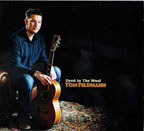 Tom
Feldmann
Tom
Feldmann
Dyed in the Wool
Magnolia Recording Company 2017
Minnesotan Tom Feldmann continues to display his impressive instrumental
talent in this album, his twelfth and his latest since 2014’s “Delta
Blues & Spirituals.” A dedicated aficionado of old-time country
blues, Feldmann in his two-decade career has revealed the profound influences
of such legends as Son House, Charley Patton, Bukka White, and Mississippi
Fred McDowell; indeed, Feldmann has released instructional DVDs teaching
their styles. However, the ten tracks on this CD are all originals. Along
for the ride this time are backing musicians Paul Liebenow on bass, Jed
Staack on drums, and Mikkel Beckmen on percussion.
Feldmann is a worthy member of the pantheon of contemporary acoustic bluesmen,
evoking stylistic comparison with such luminaries as Roy Book Binder,
Catfish Keith, Paul Rishell and Paul Geremia. His wont is a little more
restrained and melodic than that of equally illustrious contemporaries
like John Hammond and Alvin Youngblood Hart, and this release widens Feldmann’s
horizons somewhat with its undeniable bluegrass and country music influences…but
blues is still the root.
The bluegrass motif emerges most clearly in “Skip Around the Old
Oak Tree,” a brief number augmented by guest Jed Germond on fiddle.
Country music tinges are most evident in the multiple numbers featuring
Feldmann on slide or pedal steel guitar, the upbeat “Ballad of Angel
Mosley” being a sterling example. In addition to his aforementioned
early blues influences, inflections of 1960s Bob Dylan are evident in
such cuts as “Going Now but I Won’t Stay Long” and “Have
Ourselves a Time,” wherein Feldmann’s pleasing tenor vocals
morph into near-talking-blues format.
Yet another obvious influence is acoustic guitar maven Jorma Kaukonen,
erstwhile lead guitarist of psychedelic band Jefferson Airplane and roots
blues rock group Hot Tuna. (Feldmann is a frequent teacher at Kaukonen’s
annual Fur Peace Ranch music seminars in Ohio.) In fact, “Potato
Soup Instrumental,” the only instrumental of the album, indubitably
evokes memories of the instrumental track “Embryonic Journey”
from the Airplane’s classic 1967 album “Surrealistic Pillow.”
Toward the end of the set, “Well Done” and “Shine Upon
Everyone” mine a recurrent devotional theme in Feldmann’s
music and lead to the final tune, the upbeat “Hallelu Thanks Be
to God.” Although of only a short half-hour duration, “Dyed
in the Wool” is another fine showcase of Feldmann’s playing
and songwriting prowess.—Steve Daniels
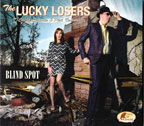 The
Lucky Losers
The
Lucky Losers
Blind Spot
Dirty Cat Records 2018
The duo of singer Cathy Lemons and singer-harmonica player Phil Berkowitz
actually make all of us listeners fortunate winners with this, their third
album. Based in San Francisco, the duo presents eleven quality songs backed
by Robi Bean on drums and Chris Burns on keyboards, who both have been
with the group since its inception. Joining on this outing are Ian Lamson
on guitar and Endre Tarczy on bass, with former bassist Tim Wagar making
a brief appearance. Also lending a hand are percussionist D’mar
and several horn players, most notably Bay Area sax expert Nancy Wright.
All are guided by the steady hands of Lemons, Berkowitz, and noted producer
and guitar maven Kid Andersen.
The eleven tracks were composed by the two principals, all but one in
cooperation with Danny Caron. Caron, former guitarist with the legendary
Charles Brown and now for many years with the excellent zydeco-blues band
Tom Rigney and Flambeau, lent a hand on several tracks of “In Any
Town,” the band’s previous release; here he plays a major
role.
This is not a straight blues album; there are no country or Chicago blues
tropes; if anything, it’s a rhythm-and-blues set…but it’s
undeniably bluesy. Lemons and Berkowitz handle the vocals deftly, and
when they sing together they create pleasant harmonies. Berkowitz is skilled
on harmonica, and the supporting cast is impeccable throughout. In addition
to the expected sterling guitar work by Andersen, who wields his six-string
on a half-dozen cuts, kudos also go to guest guitarist Laura Chavez, formerly
in the band of the late chanteuse Candye Kane. Chavez’s leads on
“Take the Long Road” and “Supernatural Blues”
make those two of the best tracks on the album. Also notable is the quirky
“Make a Right Turn,” which begins with a distinct reggae vibe
and morphs into a country tune, bolstered by the lyrical contribution
of Annie Staninec on violin.
The set ends with the delightful “You Left It Behind,” a talking-singing
musical dialogue between Lemons and Berkowitz that leaves us with a smile
on our face and anticipation of more to come from this entertaining band.—Steve
Daniels
 Joyann
Parker
Joyann
Parker
Hard to Love
Hopeless Romantics Records 2018
For her second album, Minnesota-based Joyann Parker and her adept quartet
of band cohorts serve up a roiling stew, a baker’s dozen songs comprised
of rockers, soul ballads, and a couple of shuffles. All were written by
Parker with guitarist Mark Lamoine, and on various tracks Parker plays
guitar, trumpet, and piano.
Parker’s singing, though, is the undisputed focus. This CD could
equally be entitled “Adventures on the Vocal Edge.” Parker
has a wide singing range, able to segue from brassy to smooth to sultry
in the space of a bar or two. Her rapid twists and shifts often leave
her on the precarious rim of shrillness or dissonance…but she never
slips over that edge, instead remaining pitch-perfect. The result is compelling
and commanding. Her singing reminds me of an amalgam of the styles of
fellow contemporary blueswomen Janiva Magness, Shemekia Copeland, and
Eden Brent; lofty company!
The set commences with “Memphis,” a hard rocker that is succeeded
by “Envy,” a jaunty shuffle highlighted by some crunchy guitar
riffs (presumably by Lamoine; liner notes fail to identify individual
song contributors). Next up are “Home,” a lengthy soul ballad
graced with Tim Wick’s organ fills and a fine guitar solo; and then
“Dizzy,” another pithy rocker.
Rhythm section bassist Michael Carvale and drummer Alec Tackmann then
provide the deft syncopation on “Jigsaw Heart” (not the same
song as an identically named Brent tune), with Wick adding nice tinkly
piano and wah-wah guitar making one of its several album appearances.
The following track, “Who What When Where Why,” introduces
guest Gunhild Carling on horns to the mid-tempo shuffle.
The pattern repeats throughout the rest of the set: alternating rockers
and ballads. Skilled guitarist (and co-producer, with Parker and Carvale)
Lamoine assumes primarily a supportive role, making his brief solo forays
even more appreciated. Wick, Carvale, and Tackmann are a solid rhythm
section, and Parker hits the mark powerfully on every cut, making her
case that she deserves to be included in the echelon of top blues chanteuses.—Steve
Daniels
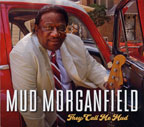 Mud
Morganfield
Mud
Morganfield
They Call Me Mud
Severn Records, Inc.
www.severnrecords.com
Mud is more than just a name, names can be powerful juju. When McKinley
Morganfield claimed the name Muddy Waters or Chester Burnett took Howlin’
Wolf they became more than just singers: they evolved into icons, powerful
figures who had the talent to make them real. Was it the name that evoked
this or their raw talent that made the name? With “Mud” Morganfield
you can tell it’s in the blood. While raised on R&B and Motown
rather than on the plantation, his voice echoes the sound and nuance of
his father. His fourth CD, “They Call Me Mud,” is definitely
Mud’s baby, producing it along with guitarist Rick Kreher, he’s
written ten of the dozen tunes, and those covers he picked were two rarities
from his Pops. The Mud Morganfield band features Mud on vocals and bass
on several cuts, Rick Kreher and Billy Flynn on guitars, Studebaker John
playing harmonica, Sumito Ariyo Ariyoshi on piano, Melvin “Pookie
Stix” Carlisle drums, E.G. McDaniel bass with Michael Jackson sax
and Phil Perkins trumpet on half the tunes.
Starting out with the title tune “They Call Me Mud” sticking
close to his father’s style of blues before taking a stronger R&B
stance, his vocals drifting towards Johnny Taylor singing it’s been
“48 Days” since you been gone, playing bass as well. “Cheatin’
Is Cheatin’” slows it up while keeping that R&B groove,
then as if in answer a heavy harp and drums drones in as Mud gives his
own howl to “Who’s Fooling Who?” this modern update
might have been just where his father could have taken it. Keeping his
family ties Mud stretches out his R& B roots on “Who Loves You”
a duet with his daughter Lashunda Williamson. A sharp guitar dances through
“24 Hours” as Mud’s a fireman putting out every fire
he sees while the harp races to keep up. The harp starts out “Oh
Yeah” like Sonny Boy’s “Help Me” as Mud drifts
towards the beginning of Muddy’s “Mannish Boy.” The
horns kick in to overdrive then cruise “Rough Around The Edge”
with the piano and guitar picking up the slack between Mud’s smooth
vocals depicting his rough behavior. Dipping back to his Pop’s tunes,
“Howling Wolf” has the slide whining and harp crooning in
response, while “Can’t Get No Grindin’” was taken
from one of Muddy’s last bands - both are so authentic they could
be Chess outtakes. Mud leads the finale on bass for the instrumental “Mud’s
Groove” with Billy Branch’s light airy harp hitting a War-like
groove.
Mud Morganfield has dedicated “They Call Me Mud” to his godfather
James Cotton and Barrelhouse Chuck, but let’s not muddy the waters,
this is all about Mud.—Roger & Margaret White
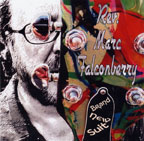 Rev.
Marc Falconberry
Rev.
Marc Falconberry
Brand New Suit
MarcFalconberry@hotmail.com
Marc Falconberry grew up the son of a big band musician but he says it
was hearing a Muddy Waters record that set his musical journey. He got
a guitar at fourteen and honed his skills in the fiercely competitive
Detroit music scene of the ‘60s, playing the Grande Ballroom, where
blues acts routinely shared the stage with rock icons. After gigs Marc
would venture to inner city blues clubs to witness real blues and that’s
where Falconberry found his calling. Heading to LA. in the ‘70s
his fervent professing the blues earned him the title of “Reverend,”
opening for major acts. Returning to his hometown in the ‘80s he
stuck to his roots playing traditional Detroit electric blues with a few
like-minded musicians. With Falconberry’s “Brand New Suit,”
his first new recording in a decade, he’s working with those long
time musical collaborators Joe LaBeau blowing sax, Andy Szymanski tickling
the ivories and Wesley Smith and Jon Johnson holding it all together on
bass and drums with the Rev wailing on guitar and vocals. All but two
tracks are originals and he’s woven these fine blues threads together
for his “Brand New Suit.”
The two covers are Taj Mahal’s “She Caught The Katy,”
a slow delicate solo acoustic guitar, it’s Marc’s deep expressive
vocals that let’s that train ride and Brownie McGhee’s “Don’t
Lie To Me,” an upbeat full band sashay. With his originals Falconberry’s
vocals are deep and wide open as he slides up and down the strings like
swerving along “forty miles of bad road” on “Often Deep
and Wide,” which sounds like it could be a lost Savoy Brown cut.
Marc sings of his frustrations with “My Ride Won’t Stay Lit”
as LaBeau blasts on sax and the guitar mimics mechanical problems. Swinging
into a groove with sax and organ Marc tells how in his youth he’d
tangled with “That New York Woman,” letting loose with some
hot guitar then warns you better “Tell Your Wife Everything”
then he goes solo bearing his heart with “Empty Bed Blues.”
Cooling things down with a smoky number, Marc hopes his luck will improve
if only he can get that “Brand New Suit (from Chicago)” and
while the story is entertaining it’s the band that shines. “Good
Morning Miss Meredith” has a Latin beat and slide guitar that goes
from a whisper to a roar. Reworking one of his party standards, “Goin’
To Hamtramck” recalls the heyday of the Attic Bar and the good times
that were had. As a finale “Maybe My Blues Is Real” is the
proof that Marc is the real deal, a slow bari sax and guitar against the
whir of organ, with heartfelt vocals and just an edge of doubt in his
voice as he questions his life.
The Rev. Marc Falconberry has dedicated his life to blues and this “Brand
New Suit” should bring him to a brand new audience.—Roger
& Margaret White
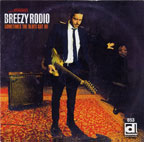 Breezy
Rodio
Breezy
Rodio
Sometimes The Blues Got Me
Delmark Records breezyrodio.com
Breezy Rodio is a real breath of fresh air on the Chicago scene, laying
down some of the best old school blues on the planet. Originally from
Italy, Breezy (Fabrizio) moved to New York, relocated to Chicago and was
Linsey Alexander’s guitarist/bandleader for more than a decade.
Rodio released his first solo recording, “Playing My Game Too,”
in 2011 followed with “So Close To It” in 2015 but his first
major label release, “Sometimes The Blues Got Me,” is a giant
leap forward weighing in at a big seventeen songs featuring eleven originals.
Backed by an ace Chicago band of Sumito “Ariyo” Ariyoshi on
piano, Chris Foreman organ, Light Palone bass, Lorenzo Francocci drums,
with a horn section made up of Ian Letts and Ian McGarrie on saxes, Art
Davis and Constantine Alexander on trumpets. But it is Breezy’s
guitar and vocals that stand front and center on every song.
Leading off Breezy’s blues is “Don’t Look Now, But I’ve
Got The Blues,” written by Lee Hazelwood and first recorded by B.
B. King, his vocal is a full throated roar trailing to a delicate quiver
with a guitar that would do the King proud. Following with more B. B.
blues you can hear Lucille ringing on “Make Me Blue” and “I
Love You So” comes off as a swinging ‘50s era big band blues
shouter and wrapping up his King tribute switching from Lucille to Lucy
with Albert King’s “Wrapped Up In Love Again.” Closing
out the covers Breezy pulls out a near perfect rendition of T-Bone Walker’s
“I Walked Away” and classic drummer Clifton James’ song
“Chicago Is Loaded With The Blues” featuring Billy Branch
on vocals and harp. Starting his originals Breezy really gains his gusto
on a delicate guitar of “Let Me Tell You What’s Up,”
an easy swinging old time feel as a horn section swaggers along building
in power till he seems to be shouting from the roof tops. The horns back
every phrase as he sings “The Power Of The Blues” that have
taken him around the world and when the guitar and the keys hit their
solos you could lose yourself in the journey. Other gems in this collection
include the instrumental “A Cool Breeze In Hell” sounding
like a lost Albert King instrumental, the Albert Collins-like “One
Of A Kind” and when you tell me I drink too much, he thinks “You
Don’t Drink Enough.” The title tune is classic Chicago blues
when “you think I’m a star, because I play guitar, but when
I take a break, I’m sitting in my car,” sometimes he’s
got the blues but “Sometimes The Blues Got Me.”
With seventeen solid tracks Breezy has mastered that old school feel yet
gives each one a spin that is unique and true to the title, “Sometimes
The Blues Got Me.” He’s got it. —Roger & Margaret
White
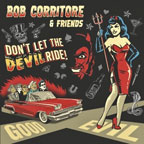 Bob
Corritore & Friends
Bob
Corritore & Friends
Don’t Let The Devil Drive
Southwest Musical Arts Foundation
P.O. Box 3310, Scottsdale,
Arizona 85271
Rare is the contemporary blues release these days that spot-on conveys
a fresh and forceful approach to channeling that know-it when-you-hear-it,
“old school” feeling while still decidedly keeping the music
relevant to the modern day blues landscape. Enter Bob Corritore’s
latest self-released project, that presents highlights from nine different
recording sessions from 2014 to 2017, where the harmonica ace is constantly
surrounded by an all-star team— particularly vocalists like Alabama
Mike (his lowdown, late-night lament “Blues Why You Worry Me”
and the vividly cautionary title tune are picks), Sugaray Rayford (great
job on the nearly seven minute jockey blues about a legendary three-legged
horse called “The Glide”) and the Tail Dragger, who delivers
a moaning, “down on my knees” vocal alchemy on the reverb-blessed
“Thundering And Raining.” Also putting in formidable vocal
appearances are Oscar Wilson, with a stellar recall of Little Walter’s
galloping “Tell Me Mama,” as well as Willie Buck, George Bowman
and gravel voiced Bill “Howl-N-Madd” Perry—who exhibits
a one-of a-kind, chanting energy concerning his “gone, gone, gone”
girlfriend “Willie Mae.” Sidemen include the best in the biz—from
Jimi “Prime Time” Smith and Henry Gray to Junior Watson (that’s
his guitar on “The Glide”) to Bob Stroger and Big Jon Atkinson
and more. Throughout, Corritore’s harmonica work is nothing short
of stupendous. !!!—Gary von Tersch
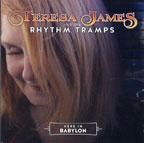 Teresa
James and the Rhythm Tramps
Teresa
James and the Rhythm Tramps
Here In Babylon
www.teresajames.com
Houston, Texas born Teresa James started singing long before she headed
to LA. and with her Texan drawl there’s no denying this little lady
is from the Lone Star state. Through hard work Teresa has made a name
for herself performing as a backup singer on numerous television and movie
soundtracks as well as with artists like Marcia Ball, Levon Helm and Eric
Burdon. Together with her longtime partner and bassist Terry Wilson they’ve
produced Teresa’s tenth release, “Here In Babylon.”
Once again Terry has penned the tunes himself or with fellow bandmates
on all but one track. Joining them in the studio are some of the West
Coast’s top tier musicians and the whole CD was tracked “live”
in two days with Billy Watts on guitar, Jay Bellarose on drums and Teresa
playing piano and Wurlitzer. They filled out that live sound adding Mike
Finnegan on B3, Darrell Leonard on trumpet, Joe Sublett on sax with some
friends and family adding background vocals.
Bellarose’s drum cadence sets the pace for James’ electric
piano as she chants the battle cry of “Here In Babylon” and
Watts’ slide rings the strings. Slowing to a gentle sway, Teresa’s
seductive Texas accent has a touch of sadness as she sings “I Know
I Ain’t Been So Perfect,” then horns join in with Teresa’s
strong vocals and positive message the backup singers chant keep your
“Head Up, Heart Open.” The B3 sets the mood with some mellow
vibes as Teresa reminisces “I Keep Drifting Away” with a sensuous
quiver of sadness that floats over the band. With a second line beat,
mean guitar licks, full blown horns and Teresa’s sultry tone sings
“Give Me A Holler.” The guitar grinding up against piano has
Teresa telling the legend of the crossroads on “Ground Zero”
her vocals soulful yet hauntingly powerful. With stinging guitar, smoky
horns and light piano Teresa gets sassy as she replies to the chorus of
“You Had To Bring That Up” then strutting with some funky
guitar and B3 declaring “Hold On.” A slow rhythm and haunting
touch on the keys has Teresa delivering one of her most powerful vocals
on “The Day The Blues Came To Call,” then swings into a rockin’
boogie with “I Gotta Roll.” Teresa points out with powerful
lyrics and strong vocals the time has come for this twenty first century
woman to stand as an equal to her “21st Century Man.” Finishing
up with a Bo Diddley beat Teresa declares “Find Me A Bar”
with a real good band, cause this girl is on a mission.
With her sweet Texas twang Teresa James shows a range from a little bit
classy to a little bit country but all woman and “Here In Babylon”
is an inviting destination.—Roger & Margaret White
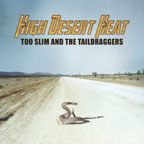 Too
Slim and the Taildraggers
Too
Slim and the Taildraggers
High Desert Heat
Vizztone 2018
Tim Langford has now been “Too Slim” for thirty-two years,
but there is no way to characterize “High Desert Heat,” his
twentieth album, as thin. Instead, it is replete with the full, crunching
guitar chords that have graced most of his musical output. With Jeff Fowlkes
on drums and Zach Kasik on bass, the Taildraggers trio delivers nine original
songs and one cover of boisterous blues rock and soulful blues.
The cover, which opens the set, will be familiar to many of us of a certain
age: “Time Has Come Today,” an eleven minute anthem released
exactly fifty years ago by The Chambers Brothers. Slim and cohorts truncate
it to four minutes and goose up the tempo slightly, but the main difference
from the original is emphasis less on Langford’s vocal -which is
more than adequate, rough and raspy - in deference to the propulsive drums
and bass.
The next track, “Trouble,” is a shuffle which introduces guest
harmonicat Sheldon “Bent Reed” Ziro, who acquits himself well,
nailing some tasty high notes along the way. It’s followed by “Broken
White Line,” the first of four tunes in a row which spotlight Langford’s
nasty but nifty power trio guitar attack.
Then we get a little respite from intensity as the tempo eases on the
longest track of the set, “Run Away,” with Langford deploying
a near-spoken vocal; and the even slower “A Little More Truth”
sports Slim singing strikingly like the late Tom Petty, and delivering
some pretty and lyrical single note guitar leads. The style is emulated
yet again in “Lay Down Your Gun,” and tweaked farther into
the slow blues spectrum with the last cut, the title tune, an ethereal
instrumental that showcases the trio’s versatility and is my favorite
track of this spirited album.—Steve Daniels
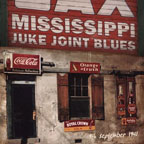 Mississippi
Juke Joint Blues: 9th September 1941
Mississippi
Juke Joint Blues: 9th September 1941
Various Artists
Rhythm & Blues Records 4CD/Bonus Disc
www.rhythmandbluesrecords.co.uk
The date above, three months before the bombing of Pearl Harbor, is significant.
Clarksdale, Mississippi, the birthplace of Jackie Brenston, Son House,
Ike Turner, Eddie Boyd and John Lee Hooker and was also home to five black
taverns visited by intrepid Library of Congress researcher Lewis Wade
on the 9th of September in 1941. Entertainment in each of the cafes and
taverns (the Chicken Shack, the Dipsie Doodle, Lucky’s, the Messenger
Café, the still-in-business Pool Room and the New Africa) was the
neon-lit jukebox and its choice of records—all painstakingly listed
by Wade for posterity. How cool—now you can sit in the comfort of
your home, pull yourself a beer and, for example, listen to the sounds
a 29 year old Muddy Waters, from nearby Stovall, might have heard on a
night out in Clarksdale on that far-gone September date. The trade magazine
Billboard created its first chart for black music in 1942, calling it
Harlem Hit Parade and it was initially dominated by big bands, vocal groups
and jazz singers. Likewise, the music on these five discs is in the same
vein, with nearly half the selections featuring black jazz and swing bands—Count
Basie and Louis Jordan top the list with five discs each. Mississippi-born
Lil “Romance In The Dark” Green proves Clarksdale’s
favorite female blues thrush with three entries, while Walter Davis’
pleading “Come Back Baby” is the only record that shows up
on all five lists. Other blues singers that make an appearance include
Tommy McLennan, Blind Boy Fuller, Roosevelt Sykes, Washboard Sam, Georgia
White and Peetie Wheatstraw along with the big band likes of Andy Kirk,
Jimmie Lunceford, Woody Herman, Earl Hines, Artie Shaw, Earl Hines, Louis
Armstrong and vocalists Bing Crosby, Jimmy Rushing, Ella Fitzgerald, Big
Bill Broonzy and Fats Waller. Among many other artists. A bonus disc,
available to set purchasers, is more of the same, beginning with Count
Basie’s “9:20 Special” (Okeh 6244) and ending, 23 tracks
later, with Gene Autry’s version of “Maria Elena” (Okeh
6435) along with the likes of two renditions of “Keep Cool
Fool” by both the Ink Spots and Erskine Hawkins and Lil Green’s
dynamic “Give Your Mama One Smile.” The sound, throughout,
is great—an eye-opening collection that is an aural time capsule
of sorts. —Gary von Tersch
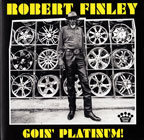 Robert
Finley
Robert
Finley
Goin’ Platinum
Easy Eye Sound 2017
The blues world has been fortunate over the last few years to benefit
from the emergence or rediscovery of a number of excellent singers; Wee
Willie Walker, R. L. Boyce, John Blues Boyd, and recently deceased Nick
Nixon come to mind. Robert Finley joins this roster with a flourish. This
man can sing!
A street singer for many years, Louisiana native Finley abandoned performance
to ply his trade as a carpenter. Because of recently diminished vision,
his carpentry career has ended, but serendipity led to his rediscovery
by Music Maker Foundation and the release of a debut album in 2016. Subsequently
Dan Auerbach of the popular blues rock duo Black Keys was introduced to
Finley, was smitten by his singing ability, and has produced this album
as well as writing or co-writing all ten of its songs and playing guitar
throughout.
The title allegedly was chosen in jest by Finley, predicting a major success
for the CD. He may be overly optimistic, but accolades are well deserved.
My only regret is that the set clocks in at slightly over a half hour;
twice as much would have been fine.
The ten tracks provide a robust tour through rock-and-roll, soul, gospel,
and hill country blues, Finley demonstrating his mastery of each. Each
song has its own charms, and each is bolstered by a crew of lauded sessions
musicians who mesh gracefully. There are some surprises: for example,
the appearance on various cuts of marimba, glockenspiel, vibraphone, mellotron,
and harpsichord - not your usual blues instruments. Two women singers
also make frequent appearances; their contributions vary from ethereal
Leonard-Cohen-style backing to 1950s-1960s doo-wop accompaniment. The
contrast may be jarring to some hardcore blues lovers, but it’s
certainly innovative.
Speaking of 1950s-1960s: rock guitar icon Duane Eddy even participates
on one track - one of my favorites - “You Don’t Have to Do
Right,” which is distinguished by his electric guitar in tandem
with Auerbach on acoustic. It’s preceded by another of my favorites,
“Honey, Let Me Stay the Night,” a plaintive and somewhat amusing
rocking plea for shelter (and maybe some loving) featuring those background
vocals again. Finley absolutely nails both of those…as well as every
other cut. Bring it on, Robert; I’m ready for more.—Steve
Daniels
BOOKS
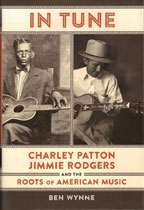 In
Tune: Charley Patton, Jimmie Rodgers, and the Roots of American Music
In
Tune: Charley Patton, Jimmie Rodgers, and the Roots of American Music
By Ben Wynne
Louisiana State University Press 2014
Dozens of books have been written about Robert Johnson, widely regarded
as “King of the Delta Blues” since Columbia Records released
an influential vinyl collection of his 1930s songs decades ago. There
is dispute, though; many historians and blues aficionados instead deem
Charley Patton, born a generation earlier than Johnson, as the true king.
Much less has been written about Patton, a deficit here addressed by his
fellow Mississippian Ben Wynne, who attempts to place Patton in cultural
and historical juxtaposition with seminal country music great Rodgers
while analyzing their mutually profound effects on U.S. popular music
in the first third of the twentieth century.
Wynne’s approach is less biographical than sociological, although
there is ample personal information about both figures. Wynne clearly
has done extensive research, demonstrated by the lengthy bibliography,
myriad footnotes, a chronology of meaningful milestones in the lives of
both musicians, and a useful compendium of their recording sessions (sadly,
all too few in Patton’s case). He vividly portrays the hardscrabble
milieu from which each emerged.
Although both Patton and Rodgers were born in Mississippi around the turn
of the twentieth century, Patton of course had to deal with the brutal
racism which permeated the region and limited the aspirations and opportunities
of its African American residents. Ensconced with his family on the infamous
Dockery Farm plantation, Patton parlayed his growing aptitude as singer
and guitarist into a precarious but viable livelihood as an itinerant
troubadour. His lively performances were renowned not only for his musical
prowess, but also for his showmanship: playing guitar behind his back,
writhing on the floor, and stirring crowds into frenzies. He traveled
the juke joint and barrelhouse circuits; the fact that he survived a knife
wound to the neck by one of his lover’s irate boyfriends and after
that even survived until 1934, dying of heart failure at the age of forty-two,
is surprising given his prodigious gambling, drinking, brawling, and womanizing.
Like Patton, Rodgers grew up in deep poverty. As a white man, he escaped
the perils of racism (and indeed played music frequently with African
Americans). His mother died when he was only six and he was left with
his impoverished stepmother while his father labored on the railroad.
Rodgers himself spent years working on the railroad, earning one of his
nicknames as “the singing brakeman.” His facility on guitar
and his innovative vocalizing, replete with his famous high-pitched yodel,
landed him gigs with traveling musical troupes before his first recording
sessions in 1927 (two years before Patton’s first sessions) led
to almost instant and widespread recognition. Sadly, he had already been
diagnosed several years earlier with tuberculosis, for which at the time
there was no effective treatment. It sapped him of energy, limited his
live and studio performances, and ended his life in 1933; he was only
thirty-five years old.
Wynne makes evident the reasons why Patton and Rodgers became and remain
seminal figures in their respective musical genres, which developed in
parallel during the 1920s and 1930s as recording technology and the advent
of radio made music available and affordable to mass audiences. As valuable,
he clarifies the affinities between blues and country, their appeal to
biracial fans, and the part that music has played in mitigating the vile
racism that has afflicted U.S. culture since the era of slavery.
Wynne analyzes the music of Patton and Rodgers in somewhat basic terms,
consistent with his profession as a historian rather than musician or
critic. His efforts are not served well by suboptimal editing, characterized
by poor punctuation, multiple misspellings, and considerable repetition.
Nonetheless, this disquisition is valuable reading for both historians
of the South and blues fans.— Steve Daniels
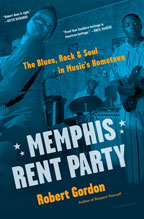 Memphis
Rent Party: The Blues, Rock & Soul In Music’s Hometown
Memphis
Rent Party: The Blues, Rock & Soul In Music’s Hometown
By Robert Gordon
Bloomsbury Publishing
Memphis, Tennessee, traditionally the initial stop for anyone from the
scratch-poor Mississippi Delta on their often hazardous journey to find
employment in the industrial North is also, reputedly, not only the fountainhead
of rock ‘n’ roll and the nation’s soul music capital
(by virtue of both Stax and Hi Records) but, for an even longer period,
the “home of the blues.” Both white and black musicians from
Louisiana, Arkansas, Tennessee and Mississippi heard each other’s
music in person, on radio and jukebox—the results were inspired
homogeneous sounds that, inevitably, influenced musicians way beyond the
city limits. First known as a blues town because of an abundance of “field
recordings,” held there in the 1920’s and 1930’s, little
beyond that happened because of the lack of a recording studio—until
enterprising Sam Phillips opened up shop and began Sun Records in 1952.
Fittingly, his initial releases were, predominantly, hard core blues (James
Cotton, Little Junior Parker, Rufus Thomas, etc.) but by the mid-1950’s
he was busy launching the careers of the rock ‘n’ roll/rockabilly
likes of characters like Elvis Presley, Carl Perkins, Jerry Lee Lewis,
Roy Orbison and Charlie Feathers among others. By 1960, the musical climate
had changed and most of the Sun artists had moved on. Yet something was
happening over at Stax Records in an old movie theater on run-down McLemore
Street—beginning with Carla Thomas’ massive hit “Gee
Whiz” and onto the deep soul music sounds of the likes of Otis Redding,
Sam & Dave, James Carr, Rufus Thomas (once more), Johnny Taylor, the
Staples Singers and Eddie Floyd Gordon. Gordon’s fervently emotional
map of Memphis, written with the anecdotal verve of a masterful storyteller,
also encompasses the more modern likes of Jeff Buckley, the iconic Jim
Dickinson (read the book), Junior Kimbrough, ill-fated genius Townes Van
Zandt and Alex Chilton, Alex Chilton, Alex Chilton. Can’t recommend
this one enough. Fat Possum also has a nifty complementary CD available.-
Gary von Tersch
Home
/ Blues Blogs /
Artist Links / Blues
Links / Videos / Store
Subscribe / Advertise
/ Back Issues
/ Contact / Staff